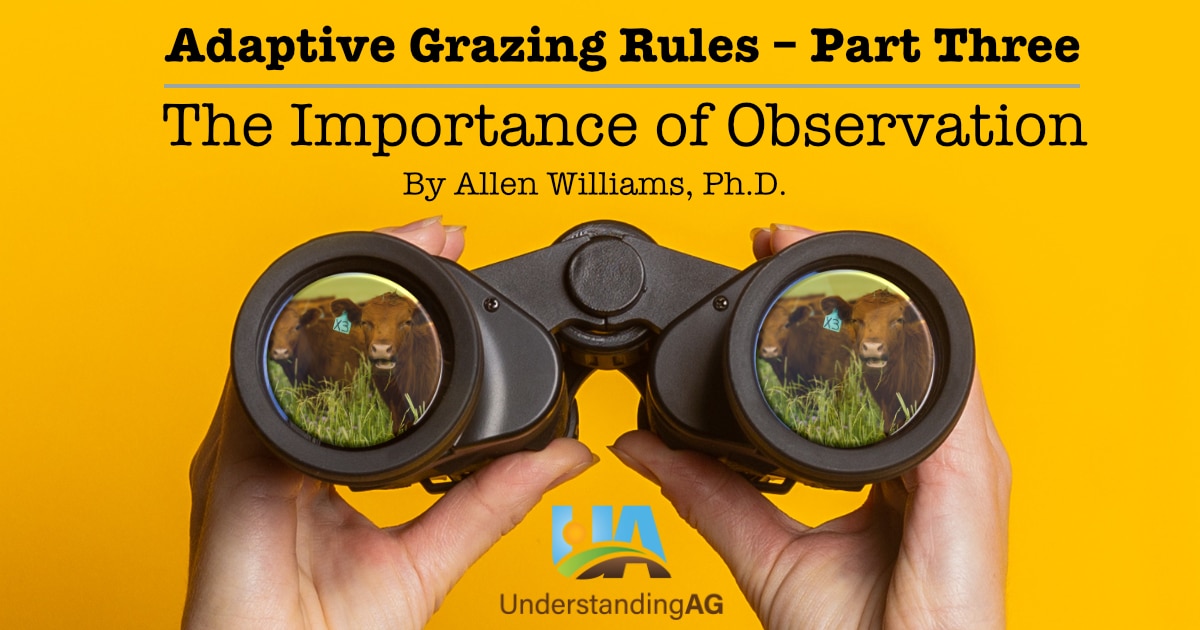
The Three Rules of Adaptive Stewardship TM have been proven to work in every region of North America and in many other parts of the world. Results are similar relative to differences in soil type, precipitation, temperature, and other environmental differences. The KEY to successful adaptive grazing is KEEN OBSERVATION. Since adaptive grazing is not a recipe, formula, or rigid system, success depends greatly on using all the powers of observation available to us. These include sight, sound, touch, smell, and even taste. Observe carefully how the animals graze when turned in to a new paddock. What are they eating? What are they avoiding? How do they move around the paddock as they graze? How much do they consume in the first hour or two compared to the rest of the time period within the paddock? Observe what the paddock looks like AFTER grazing impact. Did you achieve the desired impact? If not, why? What are you noticing relative to earthworm activity and numbers? What does the soil smell like? Are you developing deeply and highly aggregated soils? What type of beneficial insect population are you observing? Do you see Lady Beetles? Dung Beetles? Pollinators? What about your bird populations? Are they increasing? Do you see more species of birds? Are you attracting more ground nesting birds?
Observation will answer these questions. Keen daily observation allows the practitioner to develop a sharp sense of intuition. When intuition is developed, then better management decisions are made.
The Major Problem
Hundreds of thousands of biological soil tests have revealed that the majority of farms and ranches have a very similar problem. Their soils are primarily bacterial dominated and have poor mycorrhizal fungi and protozoal populations. This is manifested in low soil aggregation, poor water infiltration rates, and sub-optimal nutrient cycling.
Therefore, grazing practices should be oriented principally to encourage colonization of mycorrhizal fungi. Mycorrhizal fungi are the key consideration as they produce biotic glues that aggregate soil particles, cycle key nutrients, facilitate signaling between plants to protect against disease and pests, support plants during periods of drought, and transfer nutrients from one area of a field to another. Additionally, by producing pore space in the soil, they create the films of water that protozoa require. Protozoa in the soil are sub-aquatic organisms and travel on these films of water to hunt and consume bacteria.
Routine use of planned, purposeful disruptions is the major factor in building mycorrhizal populations in the soil. Disruptions increase plant species and macro-organism biodiversity, soil microbial species diversity, and set in motion positive compounding effects and epigenetic effects.
To maximize results from active practice of the Three Rules of Adaptive Stewardship, mass animal impact can be profound. In order to accomplish this, reduction of numbers of herds on a single farm is desired. The fewer herds and the larger each individual herd, the better the results will be.
Benefits of Positive Epigenetics
Epigenetics is defined as the Influence of environmental factors on degree of gene expression in an organism. These environmental factors can include extremes in temperature, disease, reproductive manipulation, time of year animals calve, what cows are fed when calves are in utero, what animals eat, use of chemicals (herbicides, insecticides, de-wormers, etc.), synthetic fertilizers, and even application of stockpiled manures.
It is very important that managers understand that epigenetics can be either positive or negative and are transgenerational. In other words, epigenetics follows the Rule of Compounding. Therefore, our management decisions really do matter. Following the Rule of Disruption routinely will significantly increase and improve biodiversity (plants, microbes, insects, birds, etc.) and produce positive compounding epigenetic effects.
Examples of noted positive epigenetics effects include:
- Milk components matter when it comes to starting a calf. Increased biodiversity results in higher average milk components and heathier calves pre-and post-weaning. This translates into a lifetime health benefit. Well-managed and diverse pastures and rangelands allow females to produce milk that is rich in phytonutrients.
- Positive epigenetics starts in the womb. Cows grazing highly diverse forages build positive epigenetics factors in the unborn offspring that carry over into the milk after the calves are born.
- As mothers teach their calves to graze, the calves are more likely to eat a varied diet from a highly diverse pasture. This increases the calf’s utilization of forage and reduces its dependence on mother’s milk over time. The more diverse diet increases phytonutrient richness in the calf’s diet and enhances epigenetics.
- Stockpile grazing of diverse pastures during the winter, compared to winter supplementation, has been shown to produce positive epigenetic effects.
- As grazing practices improve and the microbial profile of the forage and the soil improve, the nutrient value of those forages can improve 75-85%. This is true even within the exact same species of plants.
